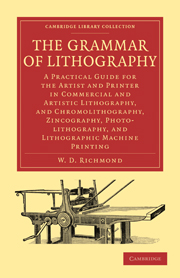 The Grammar of Lithography
The Grammar of Lithography CHAPTER I - Introductory
Published online by Cambridge University Press: 05 July 2011
Summary
Considering the importance of the subject, our task would be incomplete did we not give some practical instructions in the application of the principles laid down in the foregoing pages to printing by means of the many excellent machines now to be had of the various makers. We would especially direct the attention of the young printer to this branch of lithographic printing, because of its daily increasing importance, as machinery is now being generally acknowledged to be equal, under proper management, to the demands of very excellent work either in black or colours. Young men of intelligence whose minds are open to the reception of new ideas should pay great attention to this department of lithography, and should omit no opportunity to qualify themselves for any opening that may occur, because machinery has come so rapidly into use that the number of trained “machine-minders”—as the persons who devote themselves to superintending machines are technically designated—is very far below the actual requirements of the business. Hence, when a machine is newly introduced into an office, it is frequently found necessary to take a printer fresh from the hand-press and place him in the position of manager of a delicate and complicated piece of mechanism, with the principles of which he has no acquaintance whatever. To some men who have a mechanical aptitude the change is novel and agreeable, and provided that they have mastered the theory as well as the practice of lithography, they probably soon develop into competent machinists. On the other hand, the newlyappointed machinist may have been chosen merely because he was a good hand-printer, and may have no mechanical proclivities.
- Type
- Chapter
- Information
- The Grammar of LithographyA Practical Guide for the Artist and Printer in Commercial and Artistic Lithography, and Chromolithography, Zincography, Photo-lithography, and Lithographic Machine Printing, pp. 221 - 229Publisher: Cambridge University PressPrint publication year: 2010First published in: 1878


